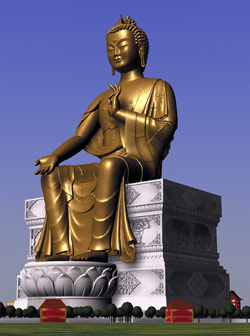Shall we trance?
“Monks, just as the river Ganges slants, slopes, and inclines towards the east, so too a monk who develops and cultivates the four jhânas slants, slopes, and inclines towards Nirvâ.na’”
“There is no jhâna for one who lacks wisdom (paññâ), nor wisdom in him who lacks jhâna. In whom there are both jhâna and wisdom, he, indeed, is in the presence of Nirvâ.na” (Dhammapada v.372).
Abstract: At the heart of Buddhism is a recipe for successful meditation; it is a balance between the right amount of effort, mindfulness and concentration. Both historically and also particularly recently the emphasis has been on mindfulness, an open awareness that enables us to remain fully present moment to moment with what we are experiencing. However to really be able to do this requires the ability to first calm the mind so that its focus is sustained and even. This is achieved through practices developing concentration and calm and it is these that are discussed here.
After the Buddha’s death and very much later, those who followed created his legend. Part of this narrative is the account of his dissatisfaction with his life, his search for something better and what he finally discovered, his awakening, Nirvana. During his search, tradition tells us, that he met two spiritual teachers, Ālāḍa Kālāma and Uddaka Rāmaputra who both taught him techniques that through intense concentration, brought about meditative trance states of calm and stillness, jhāna, so profound that his entire sense of self disappeared. However the Buddha to be was dissatisfied with these also, not believing that they would lead to what he yearned for and so, as the narrative describes, he went on and continued his journey. The details of this journey are not necessary to what I want to explore here except for the key episode that occurred when he remembered from his youth sitting quietly in the shade of a rose-apple tree where his mind settled into a light calm and stillness. This he realised was the platform from which to gain the insight necessary for full enlightenment. A state of mind that the tradition calls ‘access concentration’ which opens the door for either greater depths of calm, śamatha, or/and insight, vipaśyanā.
Perhaps because of the greater value Buddhism places on insight over calm or perhaps because of my own laziness, achieving a really solid foundation of calm in my own meditation is not something I have seriously pursued. My own teachers have taught me that I need just enough calm to steady my concentration and enable me to observe the nature of my mind which will give insight into ‘how things really are’. However exactly how much this ’just enough’ is is not something I have ever really considered until recently and finding that I can indeed look into the nature of my mind, at least occasionally and fleetingly, has made me assume that sufficient concentration had been achieved. An assumption I am now beginning to question.
Let’s go back a step and look at the narrative of the Buddha’s enlightenment. The story goes that having recognised the value of calming his mind the Buddha then, using the skill he had learnt from his previous meditation teachers, entered into the fourth level of meditative absorption, a deep trance state of one-pointed equanimity, that enabled him to experientially know what he went on to call the ‘four noble truths’ concerning suffering and its cessation. That is, through the union of calm and insight, spiritual awakening occurred. What I want to emphasise for myself here is that, at least according to the understanding of those who wrote this account, the amount of calm necessary for really significant insight is clear. What is needed is a level of ‘one-pointed equanimity’ which is arrived at through accessing the level of lucid trance found in deep concentration. This is not just five minutes worth of deep breathing but something much more powerful.
Remembering this account I began to think about my own practice and that of others I know. One frequent complaint is that our minds wander continually and are most usually distracted. That it is extremely difficult to rest and keep our mind present with our breathing, the sensations in our body, our emotions or our thoughts. I have also found that many of us have only a poor or vague recollection of the exact details of the technique of meditation we are supposedly practising. Something inside of us frequently doesn’t properly hear what needs to be done or hearing it decides to ignore or change it. A decision that actually weakens or makes impotent the method we are using. With all this in mind I have returned to the practice of meditative calm with a new interest. I have asked myself how exactly is it practised, what are the different methods, and what are the differences of experience arising from these methods? What follows is a summary of my tiny and initial research so far.
Methods
The Buddha’s noble ‘eight-fold path’ to awakening includes ‘right effort’, ‘right mindfulness’ and ‘right concentration’ as the necessary means to practice successful meditation. The combination of these three qualities has been interpreted by different Buddhist traditions over the years in different ways. The debate about what proportion of calm and of insight are necessary to produce awakening is an example of this. The concentration element, samādhi, relates to establishing a stable calm state, śamatha, – put simply, concentrate hard on something and the mind will eventually go very quiet and still and will remain in this state for an either shorter or longer period depending how good we are at it. Once resting in this calm state we are best able to recognise and be present with what is going on in our mind and, although different schools have different ideas about this, all agree this is the source of the all important insight. So what are these calming methods? Early Buddhism is extremely clear on the value of the breath for both gaining calm and insight. Sūtras that are well known to us on this subject include the ‘Teaching on In and Out Breathing’, the Ānāpāna-smṛiti Sūtra, and “The Four Foundations of Mindfulness’, the Mahā-sati-paṭṭhāna Sūtra. Again what is clear is that by repeatedly bringing our conscious awareness, our attention, to the breath, a calm state of mind that enables the sustained mindful presence of the body, emotions and mind is made possible.
Method 1.
Taking ones seat in a relaxed yet upright position, close the eyes and rest the attention on the nostrils and feel the breath as it enters and leaves. To increase concentration and diminish distractions count the out breath from 1 to 10 and then on reaching 10 begin again. Thoughts and emotions will naturally arise while doing this. These are not focused on nor followed but allowed to naturally dissolve as we continue to rest our attention on the breath and count. Those thoughts and emotions that are sufficiently powerful to distract us to the point that we forget what we are doing are named, once aware again, in a calm, kind voice in the back of the mind, ‘thinking’, and then we return to the breath and continue counting from 1.
This is a very powerful concentration practice that quickly delivers a calm state if rigourously applied. It’s strong intentionality may create some potential problems which, if they occur, must be noticed and worked with. This means that the application of its precise technique must not get stressful and the hindrance of grasping at the counting or next breath or of the calm it induces must, like any other thought or emotion, be let go of. I have found 30 minutes of this produces a deep calm that acts as a platform supporting any subsequent practice of insight. Furthermore it is also an insight practice in itself because it enables being present with thoughts and emotions without identifying with them and thus revealing their nature as ephemeral and transitory.
Method 2.
As above but counting on the in breath.
My experiments left me feeling this increased the tendency to grasp at the technique. It really does require a balance a concentration and relaxation.
Method 3.
As above but replacing the counting with the breath poem:
I have arrived – on the in breath.
I am home – on the out breath.
or an abbreviated version:
Arrived – on the in breath.
Home – on the out breath.
This is a beautiful practice given by Thich Nhat Hahn. It is softer in feeling than the counting and can induce emotion with its language. I have found it less concentrating than the breathing but also less tiring. Another variant is to split the word Bud dha on the in and out breath. I have found this is softer still.
Method 4.
As above but the concentration is placed upon the belly as it rises and falls. Counting may be done on either the breathing in or out, or not at all, making the sensation of the breathing in the belly the point of concentration.
This I tried to see if it gave a more embodied experience as it is at a lower point in our body and away from the head. Causing the attention to lower and deepen. I have found that it produces a less intense concentration and is more likely to lead to a kind of relaxed, defuse meditation with low clarity. Not desirable.
Method 5.
As above with eyes open.
This surprisingly opened easily into a state of relaxed open awareness with good clarity. Requires more practice.
The above techniques are but a few of very many and of course what works for me may not work for you and what works today may not tomorrow. However what has really surprised me is that even after a very little regular and applied practice the change in my level of concentration and the stillness this induces is significant – what it would be like if continued I have yet to find out. I feel I have gained an important insight into my practice – that it requires the right amount of concentration gained through the right amount of effort and that these two support and require the right type of mindfulness. An insight that has been staring me in the face for years right there in the centre of the Buddha’s most accessible teachings.
Finally something must be said about what we normally emphasise, the importance of having no expectation of our practice and accepting without picking and choosing what ever arises. Also there is the ideal for some schools of Buddhism to practice a practice-less practice, a non-technique meditation that has neither intention nor method. All of which sounds a long way away from the highly intentioned practices I have discussed here. Of course this non-grasping and open way of practice remains of primary importance as it is a central characteristic of insight meditation. It is essential that our meditation not be turned into another product that we control and consume. It is also true practically that it works best when we care less and that relaxation, a key quality, cannot be forcefully acquired. However all these invaluable attitudes and understandings do not mean that our practice should be sloppy or out of focus, that we flop down without care on our seat and half go to sleep. Right mindfulness includes the skill to remember we are practising and return over and over again to our breath or any other object of mindfulness. The description of the fourth level of absorption, the one the imminent Buddha stepped into liberation from, is one-pointed equanimity; this is important. One-pointed means an unwavering concentrationy means the ability to be equally present with what ever arises, good or bad, sad or mad. It is exactly the quality that opens to a place beyond fear and no longer requires defensive closures against parts of our mental, emotional and physical experience. It seems that until we begin to get at least some real inkling of this, perhaps something beginning to approach access concentration, our ability to be aware of what is going on in our self is just going to be blown around by a mind that is at sea in its own instability. No sooner do we focus on something and we are distracted by the next thought or feeling. Concentration is unsustained, calm elusive, a foundation for nothing but confusion. What the recognition of the importance of establishing an abiding calm space in our self gives is the exciting possibility of enhancing our practice and to be more continuously and deeply present with the nature of things as they really are. A practice that could so easily be motivated by a passive seeking for pleasure – a recognised hindrance – can change into one motivated by an active kind enquiry and curiosity. Perhaps the realisation that mindfulness is less like a bed and more a laboratory bench or a cook’s kitchen table.
Nigel Wellings July 2007
Togdon 2.148




